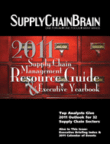
Visit Our Sponsors |
|
|
|
|
|
|
|
|
|
|
|
|
|
|
|
|
|
|
|
|
|
|
|
|
|
|
|
|
|
|
|
|
|
|
|
|
|
|

Analyst Insight: The 2009 and 2010 United Nations meetings in Copenhagen and Cancun to discuss global policy on greenhouse gas (GHG) emissions failed to create any commitments beyond Kyoto. This effectively means that on the government side, we can expect lots of debate (and chaos) in climate change action for years to come. Regional and fragmented initiatives across the world will continue to be the norm. At first glance, this lack of consensus implies that it will be best to wait before engaging in serious measurement and analysis of global supply chain carbon footprint, as GHG measurements are commonly known. But that isn't necessarily so.
--Edgar Blanco, research director at MIT Center for Transportation & Logistics, and executive director of MIT SCALE Latin America
While the potential of a unified global policy on carbon footprint is still many years down the road, there has been an accelerated convergence in voluntary corporate reporting of greenhouse gas emissions. The GHG Protocol is the de facto standard for corporations to inventory and report their carbon footprint. Numerous programs have adopted it, including the EPA Climate Leaders, the Carbon Disclosure Project, the Chicago Climate Exchange and several government organizations. To date, the protocol has focused on corporate-centric emissions (Scope 1 and Scope 2) while leaving supply chain emissions (Scope 3) up for individual corporations to include or not. Starting in 2011 this is about to change: the upcoming version of the protocol will include specific guidelines to include Scope 3 emissions, making supply chain a central part of future GHG reporting.
At the same time, two additional trends will keep pushing the role of supply chain management in carbon footprint measurement in 2011. First, there is increasing popularity of collaboration networks that facilitate sharing of emission information. This includes academics (Sustainability Consortium at University of Arkansas or LEAP at MIT), industrial associations (the EcoIndex of the Outdoor Industry Association or Clean Cargo from BSR) and government initiatives (SmartWay from the EPA) that try to bring together multiple stakeholders to devise ways to facilitate collaborative information sharing and reduction projects across their supply chains.
Second, the evolution of standards to develop product level carbon footprint labels. This is still a very fragmented space, but the two-year old PAS 2050 UK standard and its collaboration with ISO and GHG Protocol will make it economically viable for corporations.
What to do in 2011? If you are not doing it already, measure your corporate carbon footprint. This is a no-regret strategy. With a robust GHG protocol leading the way, the measurement process will highlight the data gaps and identify the future business processes needed to support a long-term reporting strategy. Also, start encouraging key suppliers and partners to initiate their corporate GHG Protocol reporting. The 2011 version of the protocol will be more aggressive in Scope 3 reporting, and their information will be invaluable.
The Outlook
If your products are customer-facing (or key ingredients of customer-facing products) keep in mind that major retailers are starting to engage in detailed product carbon footprint reporting. They will be knocking on your door soon and you will need to knock on your suppliers' door shortly afterward. All the work you (and your suppliers) do on corporate emission inventories is useful, but product carbon footprints are different. Select a few critical products and start the process. Consider engaging academia if you need help.
Even though regulation will not be the major driving force for supply chain carbon footprint initiatives, it is here to stay.
RELATED CONTENT
RELATED VIDEOS
Timely, incisive articles delivered directly to your inbox.






